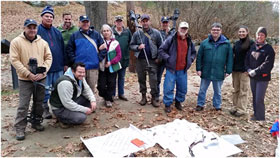|
You are viewing ARCHIVED content published online before January 20, 2025.
Please note that this content is NOT UPDATED, and links may not work. For current information,
visit https://www.nps.gov/aboutus/news/index.htm.
Contact: Nancy Nelson, Superintendent, Minute Man NHP, (978) 318 - 7811 Contact: Bob Morris, Friends of Minute Man National Park, (978) 318 - 7822

NPS Battlefield Archaeology Project Uncovers Details of the Opening Day of the American Revolution
Musket Balls Tell the Tale of a Heroic Stand Concord, MA –September 28, 2015 –On April 19, 1775, despite heavy casualties just hours before, Lexington's Captain John Parker made the courageous decision to rally his troops and pursue the British on their march back from Concord to Boston. More than 240 years later, after this heroic stand by citizen soldiers, an archaeology project using advanced technology has unearthed important details on the little known but noteworthy battle called "Parker's Revenge."
"As we enter the centennial year of the National Park Service in 2016, this project is especially exciting. Thanks to the sponsorship by our nonprofit partner the Friends of Minute Man National Park, we have been able to use technology as a new way for people to find their park and their shared heritage," said Nancy Nelson, superintendent of Minute Man National Historical Park.
Today, the 44- acre site of Parker's Revenge is on a heavily wooded hillside within the confines of Minute Man National Historical Park. Utilizing a suite of technologies, the Parker's Revenge project is reconstructing the historic 1775 landscape.
"What we have found to date is very significant. Due to the location and spatial patterning of the musket balls recovered, we now know the exact place where individuals were standing during the battle, allowing us to begin to paint a much clearer picture about what happened that day," said Dr. Meg Watters, project archaeologist.
A dropped musket ball indicates the geographical position of a combatant. In addition, since the effective range of a 1775 musket was only approximately 100 yards, a fired musket ball also provides clues to combatant positioning. Archaeological investigations have discovered British and colonial musket balls, and a 1775-era copper button from a waistcoat. These findings are significant because they are located within 80 yards of each other. The small cluster is the only occurrence of battle related artifacts over the 44-acre site, clearly identifying the position of individuals fighting that day. Continued archaeological excavations and metallic surveys will complete the historic landscape investigation.
Historians assert the Lexington militia laid down a heavy fire with a ferocity that surprised the British column, slowing its advance and exposing their rear to pursuing militia companies. After taking casualties, the Lexington militia withdrew back through the woods to continue the fight farther down the road.
"It is extremely gratifying to be able to use modern technology to reveal this history and heroism. You don't have to be a professional historian to be moved by being able to stand in the exact spot where this battle took place, look down the road and imagine the militia anticipating the British column's advance," said Bob Morris, president of the Friends of Minute Man National Park.
Once the archaeology field work is completed in November, the project will shift to development of educational resources and battlefield rehabilitation.
"Our goal is to document and understand an important chapter in the story of April 19, 1775 and honor the courage and resolve of those who stood here some 240 years ago," said Nelson. "Upon completion, this project will enable the park to convey this compelling story to current and future generations."
The Parker's Revenge project is a collaborative venture between the Friends of Minute Man National Historical Park, the National Park Service Regional Archaeology Program, the Town of Lexington's Community Preservation Fund, the Lexington Minute Men and other living history experts, Save Our Heritage, the Civil War Trust's Campaign 1776 project, the American Revolution Institute of the Society of the Cincinnati and numerous local supporters. In June, the Parker's Revenge archaeology project was the first-ever beneficiary of the Rediscovering the Revolution Battlefield Program, a joint initiative of Campaign 1776 and the Society of the Cincinnati to encourage archaeology at Revolutionary War battlefields.
###
About the Friends of Minute Man The non-profit Friends of Minute Man National Park supports the national park by funding educational programs and raising funds for restoration and preservation. For more information about the Parker's Revenge project and the Friends of Minute Man National Park, visit http://www.friendsofminuteman.org
|
Last updated: August 28, 2021
